 The national attire of Poland is very colorful, festive, and diverse. Different regions of the country have their own unique features. It’s a pity, folk costumes are very seldom used in a day-to-day life; but Polish people often wear them on special occasions (weddings, ethnic festivals, national celebrations and etc.). The most impressive pieces of Polish national clothing are headdresses. They are unique, very delicate, and sophisticated.
The national attire of Poland is very colorful, festive, and diverse. Different regions of the country have their own unique features. It’s a pity, folk costumes are very seldom used in a day-to-day life; but Polish people often wear them on special occasions (weddings, ethnic festivals, national celebrations and etc.). The most impressive pieces of Polish national clothing are headdresses. They are unique, very delicate, and sophisticated.
Read also:
Wedding traditions in Poland. Everything you should know about a Polish wedding
The 19th century brought the biggest boom of the Polish folk dress. The traditional costume of Poland is called in Polish “stroje ludowe”. Different regions of the country have their own unique features. We can name 8 biggest historic regions of Poland (therefore there are roughly 8 basic variations of a folk dress): Greater Poland, Lesser Poland, Pomerania, Prussia (including Warmia), Masovia, Kujawy, Podlasie, and Silesia.
In general, Polish traditional outfits have a lot of typically Slavic features: embroidery, colorful ribbons, wreaths made from fresh and artificial flowers, coral necklaces, male hats decorated with feathers, traditional Slavic leather footwear, wide leather belts, and many others. But at the same time, the folk dress of Poland is unique and striking.
Greater Poland
As any other region of the country, Greater Poland has its history. But in this case, historical events influenced the traditional costume of the area pretty much. During the 17th-18th century, the majority of the population of Greater Poland died of wars, diseases, and natural disasters. Then immigrants from Germany and the Netherlands started populating this part of Poland. They brought their traditions and customs that gradually mixed with the local ones. The national costume of Greater Poland is the result of such a mix. It was formed in the second half of the 19th century. And it is very bright, rich in embellishments, and festive.
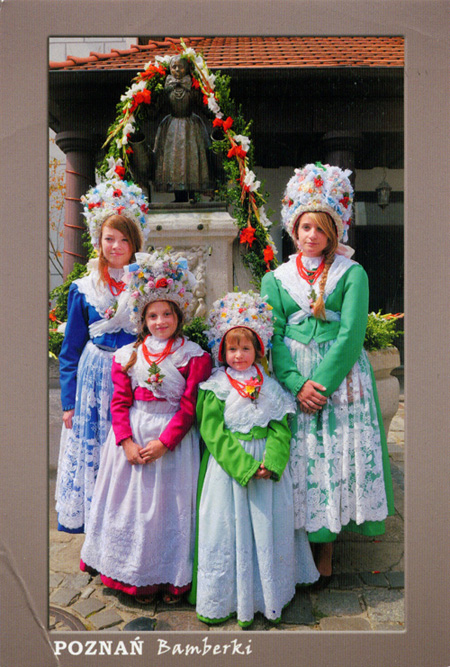
Polish postcard picturing young girls in the traditional costumes of Greater Poland region. Photo from Worldcometomyhome.blogspot.com
The male folk costume of Greater Poland is typically Polish. The immigrants fully adopted the local folk outfit. It consists of a white linen shirt, linen trousers, a vest, a jacket or coat, boots, and a brimmed hat. We will talk about the traditional Polish male dress later in this article.
The female folk costume of Greater Poland is a completely different story. It consists of a shirt, a long skirt, a jacket, an apron, a shawl, shoes, a headdress, and jewelry. The skirt is called “spódnik”, and the jacket – “watówka”. They are a match, sewn from the same fabric in the same color (usually, bright colors are used, such as blue, pink, green, yellow, etc.). The apron and shawl are white, often decorated with a lot of lace and delicate embroidery. The shawl is a triangular piece of cloth tied in a certain way: it is crossed on the chest and the ends are tied at the back. But, as usual in Poland, the most impressive piece of the folk costume is a headdress. It is called “kornet” and used for special occasions. It is large (about 23 cm high), made from cardboard, artificial flowers, ribbons, glass balls, and similar decorations. Beaded necklaces are used as jewelry.
Lesser Poland
The male folk costume consists of a white embroidered shirt, a blue waistcoat (kaftan, or vest) decorated with embroidery and tassels, striped or blue embroidered trousers, a hat called “krakuska”, a belt, and boots.
The trousers in this area of Poland can be either striped (Kraków region) or blue with embroidery (typical for the ethnic group called “Lachy Sądeckie”).
Krakuska is a hat of an interesting shape. It is usually made from a red fabric and embellished with colorful ribbons and a peacock feather.
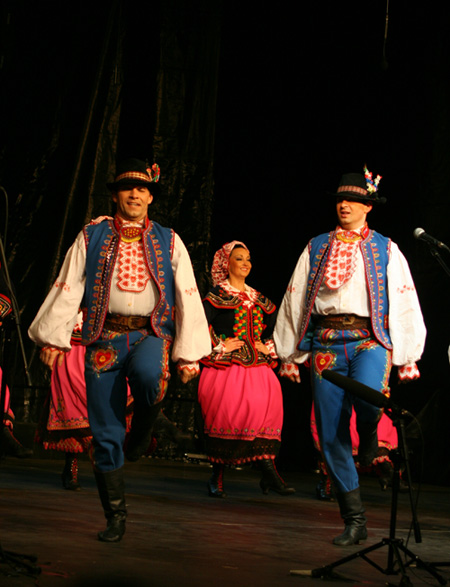
Polish dancers in folk outfits of a local ethnic group called “Lachy Sądeckie” (Lesser Poland). Photo from Wikipedia.org
The female folk costume consists of a white embroidered blouse, a vest (usually black with many adornments), a full skirt with a floral pattern, an apron, a headdress, boots, and a red coral beaded necklace as a jewelry piece.
Unmarried girls use wreaths made from fresh or artificial flowers and embellished with colorful ribbons. Married women wear kerchiefs.
The traditional men’s and women’s costumes from Lesser Poland are very bright, multicolored, and adorned with exquisite embroidery and floral patterns.
Pomerania
The most typical traditional clothing of this area is the Kashubian folk outfit. Kashubians are a Slavic ethnic group which lives in northern Poland, in Pomerania region.
The male folk costume consists of a white linen shirt, sackcloth or linen trousers, a russet coat or a two-rowed waistcoat as outerwear, an optional vest, leather shoes or boots, and a hat.
A russet coat is a long sleeveless coat made from blue fabric. It has creases in the back, a long narrow belt, a red-edged collar, and a row of buttons on the front side. This garment is not very practical, so in a day-to-day life, it was replaced by a two-rowed waistcoat.
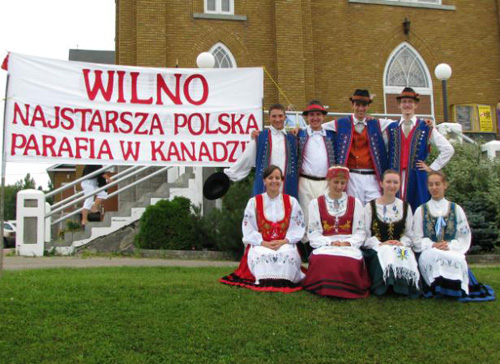
Male and female national costumes of Kashubian ethnic group (Pomerania region). Photo from Wikipedia.org
The men’s hat is pretty interesting. It is called “kapuza”. It is a very big hat made from lamb’s leather. In summer, Pomeranian males used a straw hat.
The female folk costume consists of a linen shirt, a bodice, a pleated skirt, an apron, a headdress, white stockings, shoes embellished with bowknots, and jewelry.
The shirts are embroidered. The skirts and bodices are colorful (the most popular colors are blue, red, and green). Festive aprons are made from silk and decorated with embroidery, everyday ones are made from linen. The headdress of unmarried girls is a wreath; married women wore coifs and hats. The coifs in Pomerania region are very beautiful and embellished with embroidery patterns. They are embroidered with gold, silver, and colorful silk threads. The price and beauty of the headdress show the social class of a woman.
Prussia
The most interesting area in Prussia region of Poland – if to talk about the traditional costume – is Warmia. The men’s authentic costume of Warmia is lost – nobody uses it nowadays. It is replaced with an ordinary outfit, average for Poland. It consists of a white linen shirt (sometimes embroidered), loose trousers, a jacket / vest / coat (usually, red or blue), a hat (straw hat, high brimmed hat, etc), and boots.
The female folk costume is more outstanding: bright and unusual, with a unique headdress. It consists of a white shirt, a skirt, an apron, a bodice or vest, a jacket or coat, boots, a headdress, and jewelry.
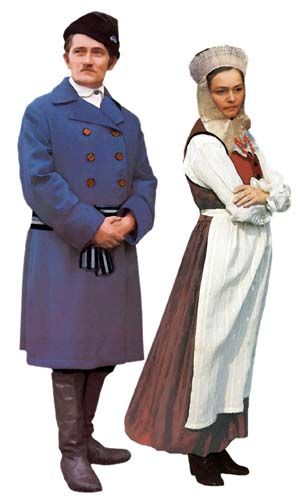
Man and woman in the traditional outfits from Warmia (Prussia region of Poland). Photo from Pinterest.com
The skirt can be ankle-length and wide, with frills, or below the knee length, with petticoats and an apron on top. Long skirts are usually monochrome and of a dark color: black, brown, dark blue, or red. Shorter variants of skirts can be more colorful, embellished with stripes of different colors on the hem. They are worn with narrow aprons. A unique piece of Warmian traditional attire is a headdress. It is a nice bonnet decorated with floral embroidery on top and with white lace and frills on the sides. It is tied below the chin with long white ribbons. The headgear looks like a small halo around the woman’s head. Such a headdress makes females look more tidy, delicate, and feminine. Only married women could wear it.
Masovia
Very colorful and bright folk costumes are typical for this region. The main feature of the outfits from the central part of Poland is colorful stripes. For example, almost every piece of a Łowicz costume (Łowicz region of the country) is decorated with stripes of all colors and sizes. The Masovian area is considered to have the most festive traditional dresses in Poland. Even today, many Poles from other regions wear Masovian outfits for holidays and special occasions.
In general, the male folk costume in Masovia consists of a white shirt with some or without embroidery, trousers, a woven belt, a sleeveless coat or vest, a coat or jacket, a headdress, and boots. The most widespread colors for the men’s costume are orange, green, violet, red, and blue. The trousers are often striped.
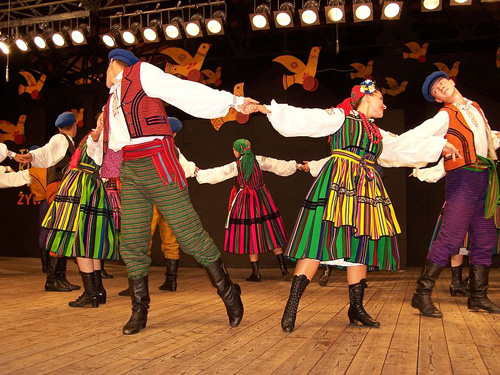
Folk dancers in the traditional Masovian clothing. Photo from Wikipedia.org, photographer – Jan Mehlich
The female folk costume in Masovia consists of a white embroidered shirt, a wide striped skirt, a bodice or vest, an apron, a headdress, boots, and jewelry. All the pieces are embroidered or decorated with patterns on fabric and other embellishments. The skirts are wide, below the knee length, and have a lot of stripes in the shades of blue, green, violet, orange, and yellow. The aprons are also striped and usually not large. The bodices and vests are adorned with embroidery, mostly floral patterns. Women use kerchiefs and scarves as headdresses. Their jewelry is beaded necklaces.
Kujawy
Time wasn’t gentle with the folk costume of Kujawy region of Poland. Not all of the pieces of the traditional dress survived. Many of them are not used today even by folk dancers and folklore experts. Some garments can be found only in the old paintings.
Nevertheless, we’ve found out that the male folk costume from Kujawy consists of a white linen shirt, a blue coat or waistcoat, trousers, a silk neck scarf, a headdress, and boots. Male headgears are interesting. There are several widespread variations: high brimmed hats (cylinder hats for noblemen), fur hats, peaked caps, sideways worn caps with a visor, wide-brimmed shepherd’s hats, and etc.
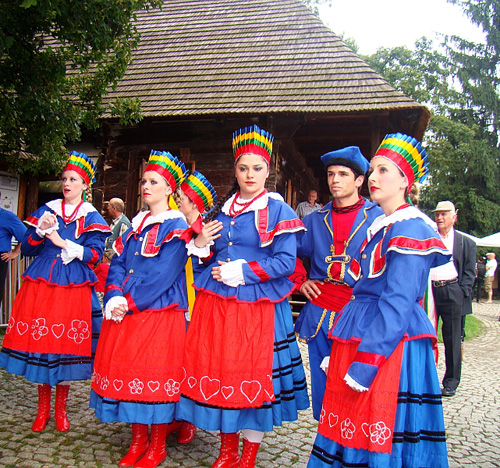
Folk dancers in modern costumes from Kujawy region of Poland. Photo from Wikipedia.org
The female folk costume consists of a white shirt (often with a wide laced or embellished collar), a wide long skirt, an apron, a corset or bodice, a coat called “sukmana” (usually, peasant women used it), a headdress, shoes or boots, and obligatory jewelry. In the 19th century in Poland, most women began to wear jewelry, not only noblewomen. They were obligatory for special occasions but even in a day-to-day life females used some pieces. Unmarried girls from Kujawy region used scarves as a headdress, while married women wore a special headpiece called “kopki” (a kind of bonnet or coif) with a kerchief or scarf on top.
Podlasie
The male folk costume consists of a linen shirt with no or little embellishments (mostly embroidery), plain linen trousers, a woven belt, a woolen overcoat, a straw hat for summer and woolen hat for winter, linen footcloths, and bast shoes. The outfit is very simple and peasant. The basts were made from the birch bark or linden bark. The bags were also woven of bark.
The female folk costume of Podlasie is more diverse. There are 3 variants of a folk dress: Nadbuzhansk costume (a colorful outfit that has a lot in common with the national costumes of neighboring countries), Wlodawa costume (southern part of Podlasie region; it is something between the Polish folk dress and the national attires of neighboring territories), and Radzinsk costume (northwestern part of Podlasie region; it is completely Polish in style).

Young girls in folk clothing from Podlasie region. Photo from Wikipedia.org, photographer – Matěj Baťha
The women’s clothing consists of an embroidered shirt, a long skirt (ankle-length or mid-calf-length), an apron, a corset or bodice, a headdress, boots, and jewelry. But every one of the variants has its unique features. The Wlodawa costume is very Slavic-looking. The pieces are made from linen cloth and decorated with embroidery: shirt – on the sleeves, skirt, and apron – on the hem. A kerchief is a popular headdress. The Nadbuzhansk costume is bright and colorful. The pieces are decorated with colorful stripes. A coif is used as a headdress. The Radzinsk costume is rather modest and plain. Embroidering is seldom used. The woven skirt and apron have vertical stripes. An intricate white bonnet is used as a headdress. The individual feature of a Podlasian bodice is lappets on the bottom. The lappets are edged with a ribbon or other embellishments.
Silesia
The male folk costume was used only to the late 19th century. The attire consisted of a white linen shirt called “koszula”, narrow linen trousers (usually, blue or dark blue) called “galaty”, a leather belt, a linen waistcoat (navy blue or black) called “bruclek”, a short winter coat called “szpyncer”, a high wide-brimmed hat called “kłobuk”, and leather boots or shoes.
The female folk costume was very widespread in Silesia region of Poland even in the end of the 19th century – the beginning of the 20th century. In the 18th-19th century, the women’s traditional outfit consisted of a short shirt, a corset, a long skirt, an apron, a headdress (a lace cap + kerchief), white stockings, and black shoes. Jewelry was used only by the noble and wealthy people.
In the 20th century, the traditional female costume in Silesia consisted of an undershirt, a short shirt with puffy sleeves called “kabotek”, a corset called “Żywotek”, a long skirt, an apron, a belt, a headdress, white stockings, black shoes, and some jewelry (women of all the classes began to use jewelry with a folk clothing).
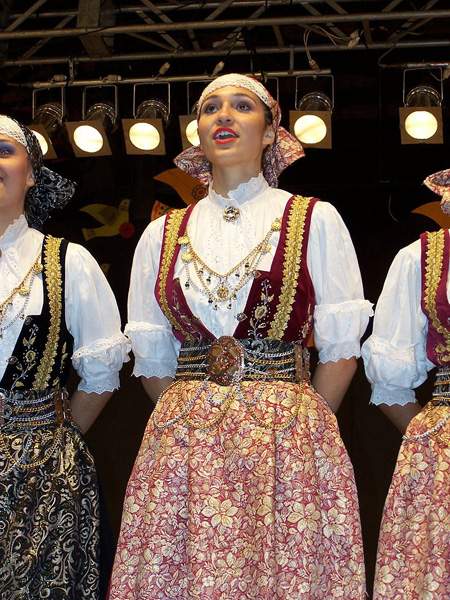
Folk singers in traditional outfits from Silesia region of Poland. Photo from Wikipedia.org, photographer – Jan Mehlich
The shirt was rather short, with elbow-length puffy sleeves (though, the wedding shirt had long sleeves). It was also decorated with the traditional floral embroidery in brown or black. The corset was very beautiful and ornate. Usually, it was made from black or claret velvet and embroidered with gold, silver, or silk threads. The shape of the corset is peculiar: its front part is widely cut in the shape of a rectangle while the back part forms a triangle. The corset is embellished with sequins, beads, pearls, and embroidery patterns.
The skirt was very wide. About 6-8 meters of fabric were used to make a skirt. There were 2 kinds of an apron: a usual one called “zapaska” that was tied at the front and a piece that consisted of two aprons – front and back. The latter apron could replace a skirt. A long ribbon was used as a belt. It was tied in a bow at the waist, and its ends reached the hem of the skirt.
The headdress usually consisted of a bonnet called “czepiec” and sometimes a kerchief on top. Czepiec was delicate and ornate, with embroidery, lace, and other embellishments. It was handmade and showed the marital status, social class, age, and wealth of the owner.
Most jewelry pieces could be found on a corset: gold and silver chains and fastenings. Festive belts also were decorated with valuables.
Read also:
Wedding traditions in Poland. Everything you should know about a Polish wedding


